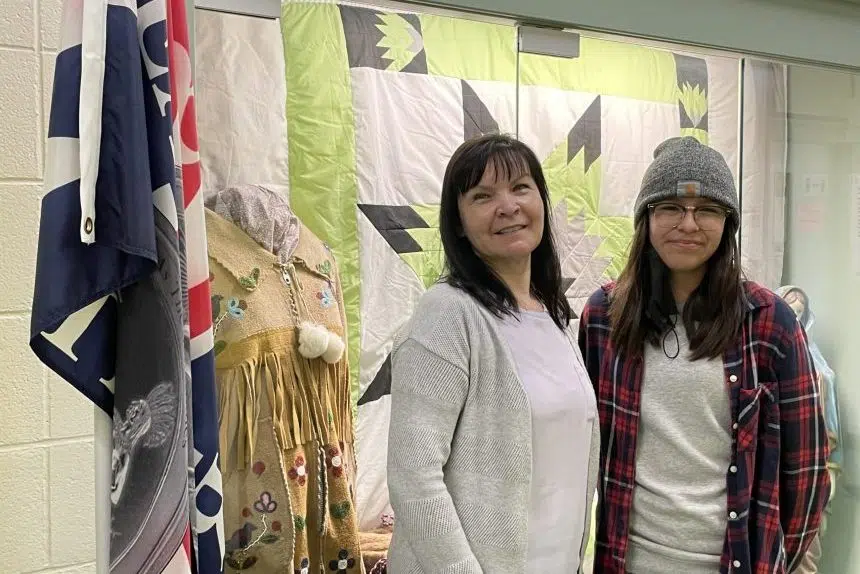While many grew up taking French classes in school, Saskatoon students today have the opportunity to study languages like Cree and Michif.
Jayce Sutherland said she couldn’t be more thrilled for her children to learn Cree at school.
Having never developed the “tongue to pronounce it,” Sutherland said she understands the language better than she speaks it. She attributed that to growing up both on and off a reserve, attending a town school, and having parents who were caught up in the residential school system.
When she came to Saskatoon for university about 10 years ago, Sutherland said her biggest fear was removing her kids from their culture and language.
Then she found St. Francis Cree Bilingual School.
“I was ecstatic,” Sutherland recalled, saying she didn’t know that sort of learning opportunity was an option for her children until she found it.
The school “validated that I was on my route where I needed to be in life,” she said.
Since then, Sutherland’s home has been slowly filling with Cree.
“(My kids) can speak it because they have a young tongue, so they’re able to learn the dialects and the sounds and the language,” Sutherland explained.
While she can say some short phrases and common words, Sutherland said it breaks her heart to know her children speak their traditional language better than their 35-year-old mother.
“I’m proud, but deep down I’m embarrassed, because I can’t pronounce what they’re pronouncing and they’re trying so hard (to teach me),” she said with emotion in her voice.
One of Sutherland’s daughters, Nadine, is currently a Grade 8 student at St. Frances Cree Bilingual School’s Bateman Campus.
The school has two campuses in Saskatoon to accommodate its growing population — about 600 students are currently enrolled from kindergarten through to Grade 9. There are plans in the works for a new campus to bring the two sites together in the near future.
Nadine said it was a challenge to start learning Cree. It was an adjustment to start learning with so many new things being thrown at her.
Now, her family speaks Cree at home daily and Nadine said she speaks Cree with her friends at school, cracking jokes and holding conversations. Nadine said she loves that so much of her day is in her traditional language, and her school always incorporates culture and their heritage into the classroom.
“I feel like it’s a part of … me and my identity,” she shared.
Cree, Michif language options
Cree language programming at St. Frances began when the Saskatoon Tribal Council invited Greater Saskatoon Catholic Schools (GSCS) to partner with the STC on a program that would help restore Indigenous language, culture and identity for Indigenous children.
The language programming at St. Frances embodies the spirit of reconciliation, said Cornelia Laliberte, who oversees the division’s Indigenous programming as manager for community and resource development with GSCS.
Bilingual Cree programming — where students spend half of each day being taught in the language — began at St. Frances in 2007. The division wants to eventually offer immersion options in Indigenous languages, which aren’t currently available.
Laliberte said she hopes to see kids learn their cultural languages enough to connect with older family members who speak the languages fluently, or to help parents like Sutherland who didn’t get the chance to learn it themselves.
Lori McAuley, principal at the St. Frances Cree Bilingual School’s Bateman location, said she grew up with Cree as her first language.
She said it’s important for students today to have options to connect to their cultures through languages beyond the traditional French and English options.
Equally important, the principal said, is ensuring a school environment exists where kids can be themselves and truly focus on learning.
“They don’t have to leave who they are at the door and pretend to be something they are not,” she said.
McAuley said she remembers feeling like an outsider at school.
“When I went to school, they always took me to be assessed … because I couldn’t make certain sounds,” she said, explaining that her Indigenous language only had about 13 sounds, compared to the 44 sounds used in the English language.
She said that usually meant she was labelled as cognitively delayed, because she couldn’t phrase all the sounds she needed to speak English in predominantly Caucasian schools.
“I was tested, tested, tested,” she said.
That experience was a big part of what led her to becoming involved in education herself, she said.
“We need to understand other languages and other people’s cultures and traditions, and not just target them and single them out as less than,” McAuley said.
Most parents she has met and connected with so far speak little to no Cree themselves, McAuley said, and they send their kids to the Cree bilingual school in the hope they will learn the language and bring it home to share with them.
But McAuley said she’s conscious of feelings of shame that can plague students at the school as they figure out how they can celebrate and be proud of their language. Encouraging the more reluctant students and supporting the enthusiastic ones like Nadine are equally important aspects of the work she said St. Frances is trying to accomplish.
McAuley said it’s important students know they are being taught by people who understand and have lived through similar experiences.
The majority of staff at St. Frances come from a Cree background, she noted, which often means they can better recognize and interact with students dealing with things like intergenerational trauma.
Culture through language
A policy about offering instruction in a second language within the GSCS states that if a school community requests a second language be offered at their child’s school, the division should make an effort to respond by working to implement that language.
That’s how Michif came to St. Michael Community School.
Students at St. Michael learn the traditional Métis language that blends French and Plains Cree for about 100 minutes each week as a classroom subject, depending on their grade level.
It has only been about six years since Michif was introduced by the school division. Laliberte said it was an easy addition to their educational framework, thanks to the work already put into the core Cree programming.
While Cree programming is a bit more common, Laliberte said there aren’t many resources available for teaching in Michif.
Because of different dialects, it wasn’t possible to simply borrow programming used in other parts of the provinces.
That meant a significant amount of the teaching material used for the bilingual Michif program offered at St. Michael had to be developed locally.
Cristin Dorgan Lee, the principal at St. Michael Community School, said she still sits down with her kookoom — Michif for grandmother — to better learn the language herself.
The award-winning school is only in its second year of bilingual programming, with students in kindergarten and Grade 1 exposed to it. She said staff are “crossing our fingers” that the program will be extended into Grade 2 next year, in time to keep fostering in-depth language learning with the students currently enrolled in the bilingual program.
“It’s not just the language, it’s the culture as well,” Dorgan Lee said.
Revitalizing families
Sutherland and her children communicate about chores and have other short conversations in Cree. Sutherland said it helps her learn the language and gives her kids the chance to practice.
Having only more recently discovered the significance of her Indigenous heritage, Sutherland said she is focused on ensuring her kids are “rooted down in the ground to stay as humble as possible and as close to their culture.”
She said her son loves to be called nikosis, Cree for “my son,” while her oldest daughter likes to be referred to as nitânis (“my daughter”). For her younger children, they love when she affectionately calls them “wolf” (mahihkan) and “big eyes” (mahkiskîsik).
“They love their names at home,” Sutherland said. “It just shows me how much they absolutely love their language. And that’s what I wanted; that’s what I was afraid my kids were going to lose.”
Laliberte said she is “really excited and happy” parents are choosing her division for their children to learn in their traditional language. Some Indigenous language programming is also offered by Saskatoon Public Schools.
It can be difficult to find instructors, Laliberte noted. She said it’s becoming easier to find qualified Cree teachers, but Michif has proven more endangered as a language, further solidifying the importance of students learning it.
The division employs seven full-time elders who assist with its traditional language programming.
Laliberte said she wants to see more Indigenous languages offered at GSCS schools along with more bilingual and immersion options. She said Dene and Salteaux have just been added as core language class options at the high school level, and she hopes to see the Michif program extended over time up to a high school level.
“I think it’s about revitalization of Indigenous languages,” Laliberte said.











